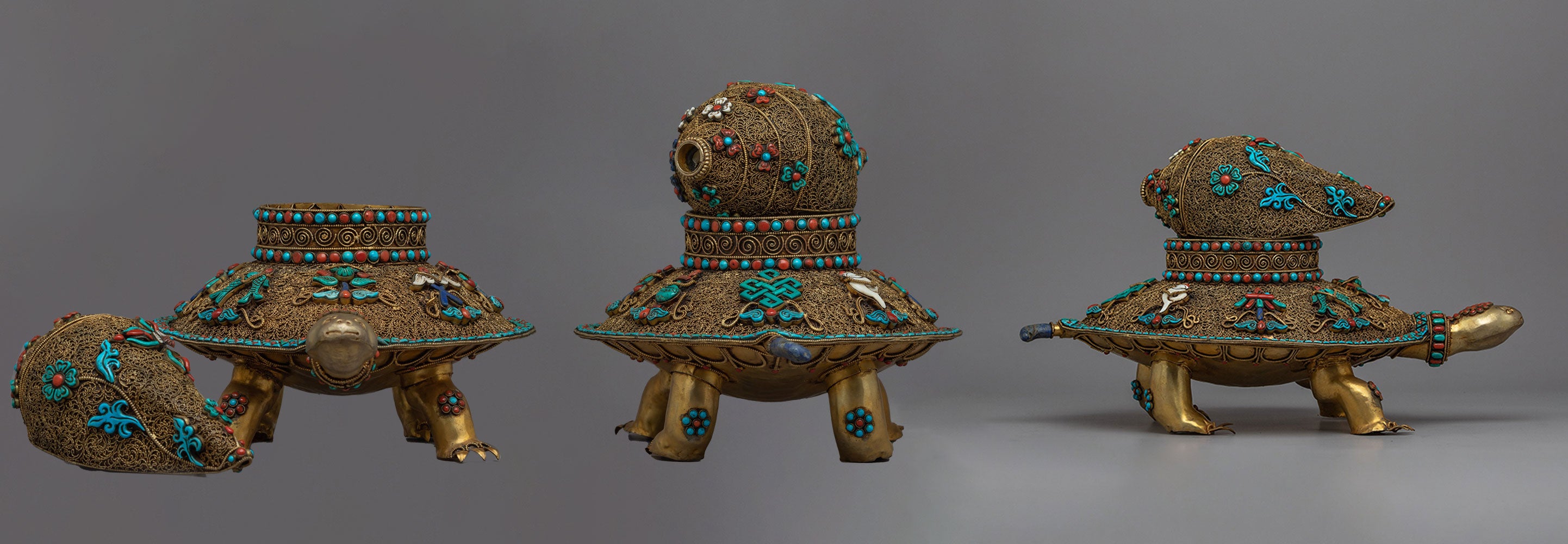Conch Shell 'Sankha' Significance in Buddhism
Historical Significance: The Conch in Ancient Texts
The conch shell, known as 'Shankha' in Sanskrit, holds profound significance in Buddhist history and literature. Ancient Buddhist scriptures, including the 'Pali Canon' and 'Mahayana Sutras,' frequently allude to the conch shell.
Beyond its ceremonial use, these scriptures symbolize the conch as a metaphor for Buddha's teachings' expansive and enduring essence. The resonance of the conch, echoing across vast distances, is a powerful analogy for the widespread dissemination of the Dharma, touching and enlightening beings in every corner of the globe.
Archaeological Findings
Archaeological findings affirm the profound role of the conch shell in Buddhism, with widespread evidence discovered at Buddhist sites throughout Asia, notably in Nepal, India, and Tibet.
Excavations have revealed diverse forms of conch shells, ranging from intact specimens to intricately carved ones. Unearthed in monastic complexes and ancient Buddhist stupas, these artifacts underscore the ceremonial and symbolic significance of the conch. Additionally, they offer valuable insights into the cross-cultural influences shaping Buddhist art and ritual practices.
Symbolic Meaning

Click here to view our Conch Shell
- The Voice of Buddha
The conch shell's connection to the Buddha's teachings runs deep. When blown, its resonant sound symbolizes the profound and extensive voice of the Buddha, inviting all beings to awaken from ignorance and follow the path of wisdom and compassion.
This symbolism carries special significance in Mahayana Buddhism, emphasizing the compassionate dimension of the Buddha's teachings, extending to all sentient beings across the universe.
- A Part of the Eight Auspicious Symbols
As an integral part of the Eight Auspicious Symbols in Buddhist iconography, the conch shell holds a specific role in representing various facets of the Buddha's teachings.
The conch signifies authority and sovereignty in this symbolic system, reflecting the Buddha's position as a spiritual leader and teacher. Its inclusion among these auspicious symbols underscores the importance of communication and the widespread dissemination of the Dharma in Buddhist philosophy.
- The Conch in Rituals and Ceremonies
Within Buddhist rituals, the conch shell assumes various roles, often sounded at the outset of significant ceremonies to mark the initiation of sacred events.
Its resonant sound is attributed to purifying qualities, believed to dispel negative energies and sanctify the space for spiritual practices.
In Tibetan Buddhism, the conch is occasionally employed alongside other ritual instruments, such as bells and drums, producing a harmonious amalgamation of sounds symbolizing different facets of Buddhist teachings.
The deep and penetrating tone of the conch is associated with the wisdom aspect of these teachings, seen as a transformative force cutting through ignorance and illusion.
The Conch Shell's Resonance: Symbolism of Om
The resonant sound emanating from the conch shell holds a profound symbolization, representing the sacred 'Om' sound, considered the primal resonance of creation.
This is why the conch is traditionally blown before rituals or ceremonies, signifying good fortune and inaugurating positive and auspicious endeavors. Contemporary belief holds that when the conch shell echoes, it purifies the surrounding environment, dispelling negativity and ushering in good fortune.
While many perceive sound merely as auditory input, its intricacy lies in its vibrational nature. Sound, comprising vibrations, originates from a source, traverses through the air, and is captured by the ear before the brain interprets it, assigning value.
The frequency, denoting the number of vibrations per second, is crucial. As all matter is in constant motion at an atomic level, everything vibrates at some frequency. According to Hindu scriptures, 'Om' is the primordial sound of creation, the original vibration of the universe from which all subsequent vibrations manifest.
Variations Across Buddhist Traditions

Click here to view our Tibetan Ritual Item
Various Buddhist traditions incorporate the conch shell uniquely into their practices and iconography. In Tibetan Buddhism, the conch is often intricately adorned with silver and precious stones, finding a place in ritual objects like trumpets utilized in monastic rituals and religious celebrations.
In Theravada Buddhist regions, the conch shell is commonly housed in temples and may be employed in processions or ceremonial events. Although its use is less ornate than Tibetan Buddhism, its significance remains paramount, symbolizing the call to adhere to the Buddha's teachings and moral precepts.
Within Mahayana Buddhist traditions, the conch frequently appears in religious art, such as paintings, sculptures, and temple embellishments. These depictions often portray the conch shell in the hands of bodhisattvas or alongside other Dharma symbols, underscoring its pivotal role as a tool for disseminating the Buddha's teachings.
The Conch in Buddhist Art and Architecture
The conch shell's representation in Buddhist art and architecture serves as a constant reminder of the widespread influence and authority of the Buddha's teachings. Within temples and monasteries, carvings and paintings featuring the conch symbolize the enduring and continuous presence of the Dharma in the world.
In addition to the table provided earlier, the following table highlights the conch's depiction in various forms of Buddhist art across different regions:
| Region | Artform | Description of Conch | Cultural Significance |
| Tibet | Ritual Instruments | Conch trumpets used in ceremonies | Represents the spreading of teachings |
| India | Cave Paintings | Conch paintings in ancient caves | Indicates historical reverence |
| China | Sculptures | Conch motifs in Buddha statues | Symbolizes purity and spiritual power |
| Southeast Asia | Temple Architecture | Conch designs in temple structures | Embodies the voice of Dharma |
The conch shell's role in Buddhism is multi-dimensional, encapsulating profound spiritual meanings while serving as a functional tool in various rituals and ceremonies.
Its presence in Buddhist art and literature further emphasizes its significance as a symbol of spiritual authority, wisdom, and the dissemination of the Buddha's teachings. From its historical roots to its contemporary reverence, the conch shell maintains its potent symbolism in Buddhism, signifying the call to spiritual awakening and the enduring resonance of the Dharma.
Beyond its aesthetic and ceremonial value, the conch shell is a beacon of spiritual wisdom, summoning practitioners and believers to enlightenment and compassionate action.














